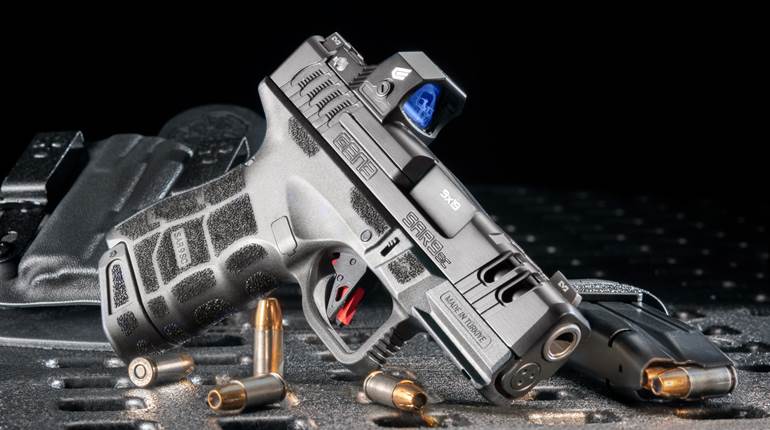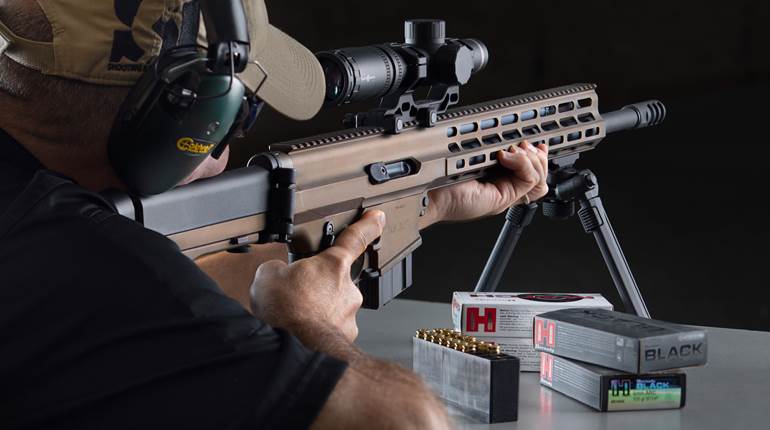
200 Rounds (400 Total)
Although it’s been a couple months since I last posted about the Rock Island .45, the gun hasn’t been idling in the safe. I used its second range session to raise the round count, make sure everything was holding together well, and get past what might be considered the break-in period, were such a period required. Thankfully, the Rock Ultra MS handled the 400th cartridge as adeptly as it did the first. As will be the case for at least the next few hundred rounds, I fed the gun a strict diet of 230-gr. FMJ ammunition from Armscor. With an advertised velocity of 849 f.p.s., I can attest that the full-power ball ammunition definitely produces fairly stout recoil. On the other hand, thanks to its all-steel construction, 40-oz. heft (with an empty magazine) and full-diameter texturing—G10 stocks, serrated frontstrap and checkered mainspring housing—the Rock Ultra MS does a great job of taming the impulse. All-steel Commanders are really the “best of both worlds” 1911 configuration, providing the handiness of a smaller pistol and the shootability of the Government model—that is, as long as your rig can hold up the weight.
150 Rounds (550 Total) 
With 400 rounds through its barrel, I thought it was time to open up a little bit and start to evaluate what the pistol can really do. To that end, I dedicated its third range session to practical accuracy. I hung several Gunsite Option Targets across the target frame and commenced practicing a very simple drill—simply raising the gun from the low ready and firing one round to the center of the target.
It’s a good warm-up as one can start slow and gradually build speed as the motions become more rehearsed and the natural index of raising the gun’s sights into the line of sight is established. On my very first iteration I actually presented the gun a bit faster than I had intended, probably due to my familiarity with the M1911 platform, but was rewarded with about the most perfectly-centered shot I could imagine. Indeed, throughout my time on the range I became more and more impressed with the accuracy of pistol, and it’s handling characteristics which do much to complement its mechanical precision. 
No issues were encountered and no malfunctions occurred. About halfway through this range session, I blacked out the white dots of the rear sight with a Sharpie and, so far, prefer the simple sight picture afforded by the rear notch and red, fiber-optic front.
175 Rounds (725 Total)
As a fun exercise and comparison, for the most recent range session I brought along my Springfield RO Elite Operator, which I had personalized a bit in an earlier project. Considering the Operator commands a price of at least double the Rock Island, I really wanted to see how the Rock Ultra MS measured up. Speaking of measuring up, I also wanted to compare the feel of the guns, the Operator being a larger Government model with the additional heft of an accessory rail on the dustcover. Ammunition used during this shoot was the same 230-gr. Armscor FMJs.
By firing 175 rounds with the Rock Island, and mixing in another 75 with the Springfield, I definitely came away with a few observations. For one, by shooting both a Commander- and Government-size 1911 together, you can definitely appreciate the benefits of the bigger gun. The size and weight do much to mitigate the recoil of the .45 ACP cartridge, and the impulse seems to be an evenly weighted push, making the Commander seem snappy by comparison. The Springfield also felt like the better fit and finished gun, which is not at all a surprise, but it was definitely more refined, as it should be for the price.
Most illuminating though, was that the Rock Island performed equally as well as the Springfield through a series of drills and practical exercises. Despite somewhat sharper recoil, recovery and realignment of the sights seemed to be equally as fast as with the Springfield. Both guns also shot perfectly to point of aim whether at 7 yds. or 25 yds. There is no doubt that the Springfield exhibits the superior design, craftsmanship and has been tuned for reliability and even comfort. That said, it was a lot of fun to see the Rock Island keep pace, shot for shot, even if its efforts felt rugged and scrappy.
As a general rule, M1911s can do with a good cleaning and lubrication every 500 rounds or so. Having shot a bit beyond that, I broke the Rock Island down at the work bench and gave it a once over. Filthy though it was, there were no red flags discovered during cleaning, though there was perhaps a few areas of wear worth keeping an eye on. Because the Rock Ultra MS used a bushingless, full-length guide rod assembly, disassembly does require a paper clip or similar takedown tool to capture the compressed spring.

Having shot the Rock Island a good deal now, and having cleaned it up and assessed its components, I have a few final thoughts. Steel guns, when well fit, can easily last a lifetime and tens of thousands of rounds as long as they are properly lubricated, and the more perishable components are serviced at the appropriate intervals. When poorly fit, under the influence of recoil the large steel components will batter each other and wreak havoc on the smaller parts. My assessment right now is that the Rock Island Rock Ultra MS falls somewhere in between, probably toward the lower end of “good” fitment. The Parkerized finish is not nearly as durable or lubricious as more modern treatments, and certain wear marks—such as those around the slide stop—betray the fact that some components are being jarred more than they should. Still, at more than 700 rounds without a single stoppage and accuracy that rivals much more expensive guns—remember, this pistol sells for around $500—it is hard to find fault with the Rock Island or its performance, so far.
More testing awaits, and time will tell if the gun can go the distance.
Additional Reading:
Range Report Part 1: Rock Island Armory Rock Ultra MS
Configured For Carry: Springfield RO Elite Operator
Dual Citizenship: The Rock Island Armory Story
Video: NRA Gun Gear—Gunsite Option Targets





































